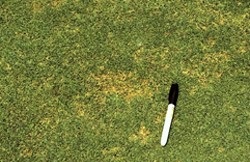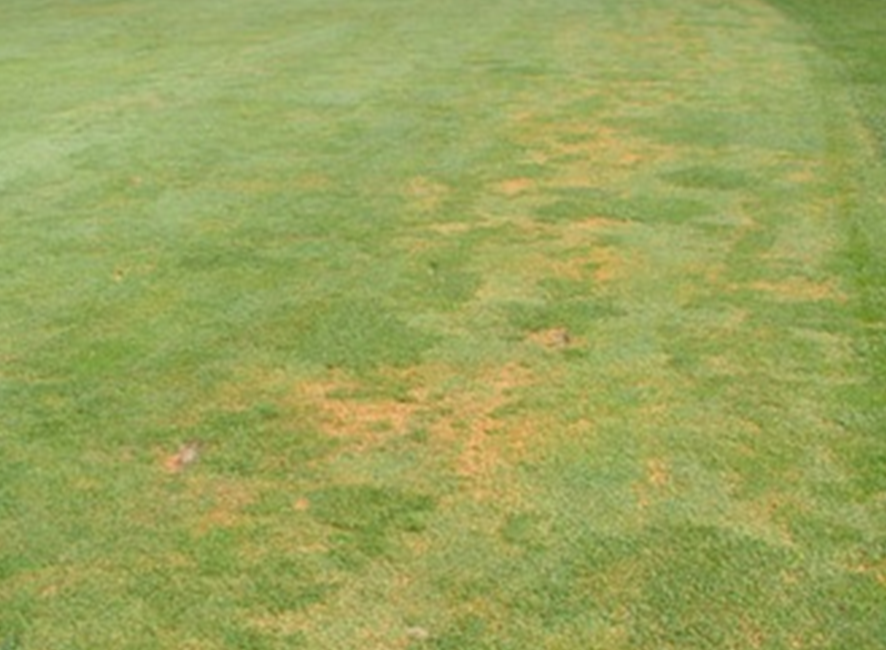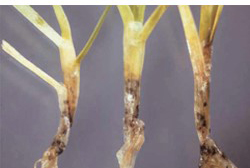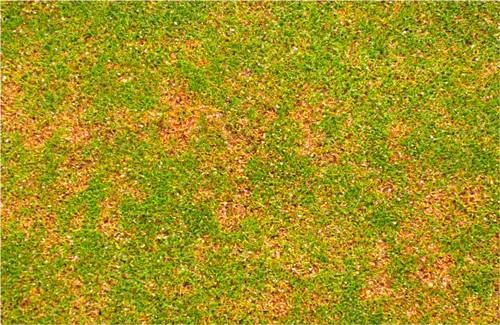Anthracnose

At this time of year one of the most common comments I hear is “I have brown patches on my greens, what is it”? That is not such an easy question to answer. It could be localised dry patch, brown patch, leatherjacket damage, take all patch or even dollar spot. However one of the most common and often overlooked is Anthracnose. The occurrence of Anthracnose has increased greatly over the last 20 years or so. This is undoubtedly linked to the ever increasing pressure from sportsmen for faster, truer and more consistent greens. Go back 20 years and there were not turf irons causing compaction issues, most greens were only cut at a maximum of 3 times a week and at a height of 4.8mm to 6.3mm (1/4th inch to 3/16th inch) and not the more commonly height seen in summer these days of 4mm or even below!

Anthracnose foliar blight
Anthracnose can result in two types of disease: foliar blight and basal rot. Foliar blight anthracnose first appears as a dry looking stressed turf with a tan/yellowing colour. With the foliar blight you can see tiny black specks and then thin hair like structures on the decaying leaf these are the fungal spores that can then attack the crown of the plant resulting in basal rot anthracnose.

Acervuli releasing fungal spores
Basil rot develops in the crown of the plant, infects the leaf and this dies back. First signs will be a general yellow/brown colour to the leaf and this decays or is easily pulled out and a more brick red colour is apparent. You can have just foliar blight anthracnose but quite commonly you will have both.

Anthracnose basal rot
The higher standards of playing surface has resulted in turf being under vastly increased levels of stress, particularly in the summer. Stress is one of the main trigger conditions that leads to the onset of anthracnose. Frequent rolling or ironing leads to quicker greens but also surface level compaction, which, along with already stressed turf is ideal for the onset of anthracnose.
Anthracnose mainly, but not exclusively, attacks (poa annua) annual meadow grass and is therefore sometimes left by greenkeepers to slowly reduce the amount of poa in the sward so that it can be replaced by bent grass. However, unless you are regularly planting bent seed into the thinning surface the most likely grass to infill the space is more poa! Once the plant is infected with anthracnose it is incapable of recovery, this is a big danger. You may see early signs of anthracnose and leave it a while as it is only attacking the poa but, if unchecked it can quickly get a hold and you can lose large areas of poa on the green.
There are a number of fungicides (Heritage Maxx and Heritage WSG, both have good control and Instrata Elite and Clayton Bestow have moderate control. For winter control Medallion TL) that have approval for the control of anthracnose on greens and these are best used preventatively but for qualified advice on which one may be most suitable for your site, the time of year and for fungicide resistance management, speak to one of the Collier Turf Care BASIS qualified advisors. The addition of Prestige Super Recovery to a fungicide adds balanced vital trace elements and reduces plant stress as well as containing a spreader to distribute the fungicide across the whole leaf, and also a rain fastener. Remember that you should not add anything to a fungicide unless it is approved and is registered as an adjuvant (look for the registered adjuvant number).
With a BASIS qualified advisor, prepare an ITM (Intergraded Turf Management plan) for your turf. Look at reducing plant stress, include irrigation levels, keep the rootzone moist but the surface dry, use a turf pigment such as Ryder to reduce UV damage, ensure adequate and appropriate nutrition, potassium silicate to strengthen the leaf and a preventative fungicide programme. Use the Collier Turf Care Disease Forecast to see when anthracnose disease pressure is high. Where possible, increase the height of cut, just 20% (for example, 3mm to 3.6mm) can make a big difference to reducing turf stress.
For expert help and advice contact Collier Turf Care Ltd on 01328 700600
Chris Humphrey MBPR FQA Technical Manager